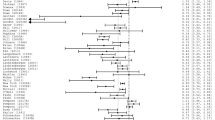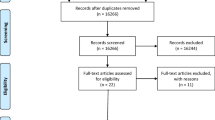Abstract
The purpose of this research is to investigate Veterans Treatment Courts’ (VTCs) operation during the COVID-19 pandemic. Since March of 2020, there have been efforts to transition to a virtual world to guarantee criminal defendants their rights in court during this public health crisis. While many courts had to adapt to the changing conditions due to COVID-19, little is known about what these changes looked like for VTCs, if they varied from court to court, and whether these changes were successful. Through a nationwide survey of VTC courtroom actors such as judges, program coordinators, and Veterans Justice Outreach Specialists, we examine how VTCs’ day-to-day operations changed during the COVID-19 pandemic as well as program retention and participants’ success in the treatment program during a public health emergency. We discuss VTCs’ lessons learned to inform other VTCs and specialty courts about best practices for continuing operations.
Similar content being viewed by others
References
Ahlin, E. M., & Douds, A. S. (2015). Military socialization: A motivating factor for seeking treatment in a veterans’ treatment court. American Journal of Criminal Justice, 41, 83–96. https://doi.org/10.1007/s12103-015-9332-4.
Baldwin, J. M. (2013). Veterans treatment courts: Studying dissemination, implementation, and impact of treatment-oriented criminal courts [Doctoral dissertation, University of Florida].
Baldwin, J. M. (2015). Investigating the programmatic attack: A national survey of veterans treatment courts. Journal of Criminal Law & Criminology, 105(3), 705–751.
Baldwin, J. M. (2017). Whom do they serve? A national examination of veterans treatment court participants and their challenges. Criminal Justice Policy Review, 28(6), 515–554. https://doi.org/10.1177/0887403415606184.
Baldwin, J. M., Eassey, J. M., & Brooke, E. J. (2020). Court operations during the COVID-19 pandemic. American Journal of Criminal Justice, 45, 743–758.
Blonigen, D. M., Bui, L., Elbogen, E., Blodgett, J. C., Maisei, N., Midboe, A. M., Asch, S. M., McGuire, J. F., & Timko, C. (2014). Risk of recidivism among justice-involved veterans. Criminal Justice Policy Review, 27(8), 1–40.
Boman, J. H., & Gallupe, O. (2020). Has COVID-19 changed crime? Crime rates in the United States during the pandemic. American Journal of Criminal Justice, 45, 537–545.
Calhoun, P. S., Elter, J. R., Jones, E. R. Jr., Kudler, H., & Straits-Tröster, K. (2008). Hazardous alcohol use and receipt of risk-reduction counseling among U.S. veterans of the wars in Iraq and Afghanistan. The Journal of Clinical Psychiatry, 69(11), 1686–1693. https://doi.org/10.4088/jcp.v69n1103.
Cartwright, T. (2011). To care for him who shall have borne the battle: The recent development of veterans treatment courts in America. Stanford Law & Policy Review, 22, 295–316.
Casey, T. (2004). When good intentions are not enough: Problem-solving courts and impending crisis of legitimacy. SMU Law Review, 57(4), 1459–1520.
Cavanaugh, J. M. (2010). Helping those who serve: Veterans treatment courts foster rehabilitation and reduce recidivism for offending combat veterans. New England Law Review, 45, 463–487.
Dillman, D. A., Smyth, J. D., & Christian, L. M. (2014). Internet, Mail, and Mixed-Mode Surveys: The Tailored Method (4th ed.). John Wiley & Sons, Inc.
Donoghue, J. (2017). The rise of digital justice: Courtroom technology, public participation and access to justice. The Modern Law Review, 80(6), 995–1025.
Douds, A. S., & Ahlin, E. M. (2019). The veterans treatment court movement: Striving to serve those who served. Routledge.
Douds, A. S., Ahlin, E. M., Howard, D., & Stigerwalt, S. (2017). Varieties of veterans’ courts: A statewide assessment of veterans’ treatment court components. Criminal Justice Policy Review, 28(8), 740–769. https://doi.org/10.1177/0887403415620633.
Eagly, I. V. (2015). Remote adjudication in immigration. Northwestern University Law Review, 109(4), 933–1019.
Elbogen, E. B., Johnson, S. C., Newton, V. M., Straits-Troster, K., Vasterling, J. J., Wagner, H. R., & Beckham, J. C. (2012). Criminal justice involvement, trauma, and negative affect in Iraq and Afghanistan war era veterans. Journal of Consulting and Clinical Psychology, 80(6), 1097–1102. https://doi.org/10.1037/a0029967.
Fan, W., & Yan, Z. (2010). Factors affecting response rates of the web survey: A systematic review. Computers in Human Behavior, 26(2), 132–139.
Fitzke, R. E., Wang, J., Davis, J. P., & Pedersen, E. R. (2021). Substance use, depression, and loneliness among American veterans during the COVID-19 pandemic. The American Journal on Addictions, 30, 552–559.
Golub, A., & Bennett, S., A (2013). Introduction to the special issue: Drugs, wars, military personnel, and veterans. Substance Use & Misuse, 48(10), 795–798. https://doi.org/10.3109/10826084.2013.816859.
Hardin, C., & Sydow, N. (2020, March 26). Treatment courts and COVID-19: Pandemic Guidance [Webinar]. Available at: https://vimeo.com/401116822.
Hartley, R. D., & Baldwin, J. M. (2019). Waging war on recidivism among justice-involved veterans: An impact evaluation of a large urban veterans treatment court. Criminal Justice Policy Review, 30(1), 52–78.
Hawkins, M. D. (2009). Coming home: Accommodating the special needs of military veterans to the criminal justice system. Ohio State Journal of Criminal Law, 7, 563–572.
Holbrook, A., Krosnick, J., & Pfent, A. (2007). The causes and consequences of response rates in surveys by the news media and government contractor survey research firms. In Lepkowski, J. M., Tucker, N. C., Brick, J. M., De Leeuw, E., Japec, L., Lavrakas, P. J, Link, M. W., & Sangster, R. L. (Eds.), Advances in Telephone Survey Methodology (pp. 499–679). John Wiley & Sons, Inc
Jalain, C. I., & Grossi, E. L. (2020). Take a load off Fanny: Peer mentors in Veterans Treatment courts. Criminal Justice Policy Review, 31(8), 1165–1192.
Jones, A. E. (2013). Veterans Treatment courts: Do status-based problem-solving courts create an improper privileged class of criminal defendants. Washington University Journal of Law and Policy, 43, 307–331.
Jossie, M. L., Blumstein, A., & Miller, J. M. (2022). COVID, crime & criminal justice: Affirming the call for system reform research. American Journal of Criminal Justice, 47, 1243–1259.
Justice, Committee, & House of Commons. (2020, May 4). Oral evidence: Coronavirus (Covid-19): The impact on prison, probation and court systems, HC 299. Retrieved from https://committees.parliament.uk/oralevidence/337/pdf/.
Knudsen, K. J., & Wingenfeld, S. (2015). A specialized treatment court for veterans with trauma exposure: Implications for the field. Community Mental Health Journal, 52, 127–135. https://doi.org/10.1007/s10597-015-9845-9.
Legg, M. (2021). The COVID-19 pandemic, the courts and online hearings: Maintaining open justice, procedural fairness and impartiality. Federal Law Review, 49(2), 161–184.
Lucas, P. A. (2018). An exploratory study of veterans treatment court peer mentors: Roles, experiences, and expectations. Drug Court Review, 1, 59–68.
Marlowe, D. B. (2009). Evidence-based sentencing for drug offenders: An analysis of prognostic risks and criminogenic needs. Chapmen Journal of Criminal Justice, 1(1), 167–200.
McIntyre, J., Olijnyk, A., & Pender, K. (2020). Civil courts and COVID-19: Challenges and opportunities in Australia. Alternative Law Journal, 45(3), 195–201.
McKay, C. (2018). The pixelated prisoner: Prison video links, court ‘appearance’ and the justice matrix. Routledge.
Menon, V., & Muraleedharan, A. (2020). Internet-based surveys: Relevance, methodological considerations and troubleshooting strategies. General Psychiatry, 33(5), 1–3.
Miller, J. M., & Blumstein, A. (2020). Crime, justice and the COVID-19 pandemic: Toward a national research agenda. American Journal of Criminal Justice, 45, 515–524.
Morton, S. M. B., Bandara, D. K., Robinson, E. M., & Atatoa Carr, P. E. (2012). The 21st century, what is an acceptable response rate? Australian and New Zealand Journal of Public Health, 36(2), 106–108.
National Council on Disability (2009, March 4). Invisible Wounds: Serving Service Members and Veterans with PTSD and TBI. https://www.ncd.gov/report/invisible-wounds-serving-service-members-and-veterans-with-ptsd-and-tbi/.
National Center for State Courts (2020). Guiding principles for post-pandemic court technology.https://www.ncsc.org/__data/assets/pdf_file/0014/42332/Guiding-Principles-for-Court-Technology.pdf.
Pedersen, E. R., Davis, J. P., Fitzke, R. E., Lee, D. S., & Saba, S. (2022). American veterans in the era of COVID-19: Reactions to the pandemic, posttraumatic stress disorder, and substance use behaviors. International Journal of Mental Health and Addiction. https://doi.org/10.1007/s11469-021-00620-0.
Qualtrics (2022). July,. For how long should you accept survey responses? Retrieved from https://www.qualtrics.com/experience-management/research/how-long-to-accept-responses/.
Rapisarda, S. S., Kras, K. R., LeMoyne, G., Hummer, D., Socia, K., & Byrne, J. M. (2024). Veterans treatment courts: A nationwide review of enacting and eligibility state statutes. Victims & Offenders, 19(1), 32–58. https://doi.org/10.1080/15564886.2023.2263451.
Reilly, E. D., Chamberlin, E. S., Duarte, B. A., Harris, J. I., Shirk, S. D., & Kelly, M. M. (2022). The impact of COVID-19 on self-reported substance use, well-being, and functioning among United States veterans: A cross-sectional study. Frontiers in Psychology, 13, 1–12.
Renz, T. (2013). Veterans treatment court: A hand up rather than lock up. Richmond Journal of Law and the Public Interest, 17, 697–705.
Riddle, H., Edwards, A., & Hardcastle, M. (2021). Covid-19 and the criminal courts. Criminal Law Review, 3, 159–162.
Rossner, M. (2021). Remote rituals in virtual courts. Journal of Law and Society, 48, 334–361.
Rossner, M., Tait, D., & McCurdy, M. (2021). Justice reimagined: Challenges and opportunities with implementing virtual courts. Current Issues in Criminal Justice, 33(1), 94–110. https://doi.org/10.1080/10345329.2020.1859968.
Rowden, E. (2018). Distributed courts and legitimacy: What do we lose when we lose the courthouse? Law. Culture and the Humanities, 14(2), 263–281.
Russell, R. T. (2009). Veterans treatment court: A proactive approach. New England Journal on Criminal & Civil Confinement, 35, 357–372.
Shih, T. H., & Fan, X. (2008). Comparing response rates from web and mail surveys: A meta-analysis. Field Methods, 20(3), 249–271.
Steeh, C. G. (1981). Trends in nonresponse rates, 1952–1979. Public Opinion Quarterly, 59, 66–77.
Terry, M., Johnson, S., & Thompson, P. (2010). Virtual court pilot outcome evaluation. Ministry of Justice Research Series 21/10.
Tsai, E. C. (2017). The practitioner’s guide to due process issues in veterans treatment courts. Mitchell Hamline Law Review, 43, 577–625.
Tsai, J., Flatley, B., Kasprow, W. J., Clark, S., & Finlay, A. (2017). Diversion of veterans with criminal justice involvement to treatment courts: Participant characteristics and outcomes. Psychiatric Services, 68(4), 375–383.
Tsai, J., Finlay, A., Flatley, B., Kasprow, W. J., & Clark, S. (2018). A national study of Veterans Treatment Court participants: Who benefits and who recidivates. Administration and Policy in Mental Health and Mental Health Services Research, 45(2), 236–244.
U.S. Department of Veterans Affairs (2021). Veterans Treatment Courts and other veteran-focused courts served by VA Veterans Justice Outreach specialists [Fact sheet] Office of Public Affairs. https://cdm16501.contentdm.oclc.org/digital/collection/spcts/id/371.
Viglione, J., Peck, J. H., & Frazier, J. D. (2023). COVID-19 and courts: An exploration of the impacts of the pandemic on case processing and operations. Victims and Offenders, 18(5), 818–841.
Warren, Z. (2023, February 28). Access, constitutional challenges plague virtual trials as courts develop in-person/virtual mix. Thomson Reuters Institute. https://www.thomsonreuters.com/en-us/posts/legal/virtual-court-trials-challenges/.
Webster, E., Huebner, B. M., Early, A. M., & Torres, L. C. (2023). Court can happen anywhere: Courtroom workgroup members’ perceptions of the challenges and opportunities of a transformed workplace. Criminal Justice and Behavior, 50(11), 1737–1756.
White, M. D., Mulvey, P., Fox, A. M., & Choate, D. (2011). A hero’s welcome? Exploring the prevalence and problems of military veterans in the arrestee population. Justice Quarterly, 29(2), 258–286.
Winick, B. J., & Wexler, D. B. (2003). Judging in a therapeutic key: Therapeutic jurisprudence and the courts. Carolina Academic Press.
Zilius, C., Dahlgren, J., Carey, S., Herrera-Allen, T., Johnson, A., & Aborn, J. (2020, December). Treatment courts and COVID-19: Adapting operations. NPC Research. https://npcresearch.com/wp-content/uploads/Impact-of-Covid-on-Treatment-Court-Report-2020-FINAL.pdf
Author information
Authors and Affiliations
Corresponding author
Ethics declarations
Conflict of Interest
We have no known conflict of interest to disclose.
Additional information
Publisher’s Note
Springer Nature remains neutral with regard to jurisdictional claims in published maps and institutional affiliations.
Rights and permissions
Springer Nature or its licensor (e.g. a society or other partner) holds exclusive rights to this article under a publishing agreement with the author(s) or other rightsholder(s); author self-archiving of the accepted manuscript version of this article is solely governed by the terms of such publishing agreement and applicable law.
About this article
Cite this article
Jalain, C.I., Stacer, M.J. Veterans Treatment Courts during the COVID-19 Pandemic: An Examination of Adaptations and Best Practices for Continuing Operation. Am J Crim Just (2024). https://doi.org/10.1007/s12103-024-09760-0
Accepted:
Published:
DOI: https://doi.org/10.1007/s12103-024-09760-0




